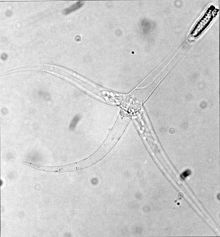This article includes a list of references, related reading, or external links, but its sources remain unclear because it lacks inline citations. (December 2022) |
| Myxobolus cerebralis | |
|---|---|

| |
| Triactinomyxon stage of Myxobolus cerebralis - note the three "tails" | |
| Scientific classification | |
| Domain: | Eukaryota |
| Kingdom: | Animalia |
| Phylum: | Cnidaria |
| Class: | Myxosporea |
| Order: | Bivalvulida |
| Family: | Myxobolidae |
| Genus: | Myxobolus |
| Species: | M. cerebralis
|
| Binomial name | |
| Myxobolus cerebralis Hofer, 1903
| |
| Synonyms | |
|
Myxosoma cerebralis | |
Myxobolus cerebralis is a myxosporean parasite of salmonids (salmon and trout species) that causes whirling disease in farmed salmon and trout and also in wild fish populations. It was first described in rainbow trout in Germany in 1893, but its range has spread and it has appeared in most of Europe (including Russia), the United States, South Africa, Canada and other countries from shipments of cultured and wild fish. In the 1980s, M. cerebralis was found to require a tubificid oligochaete (a kind of segmented worm) to complete its life cycle. The parasite infects its hosts with its cells after piercing them with polar filaments ejected from nematocyst-like capsules. This infects the cartilage and possibly the nervous tissue of salmonids, causing a potentially lethal infection in which the host develops a black tail, spinal deformities, and possibly more deformities in the anterior part of the fish.[citation needed]
Whirling disease affects juvenile fish (fingerlings and fry) and causes skeletal deformation and neurological damage. Fish "whirl" forward in an awkward, corkscrew-like pattern instead of swimming normally, find feeding difficult, and are more vulnerable to predation. The mortality rate is high for fingerlings, up to 90% of infected populations, and those that do survive are deformed by the parasites residing in their cartilage, bone, and neurological tissue. They act as a reservoir for the parasite, which is released into water following the fish's death. M. cerebralis is one of the most economically important myxozoans in fish, as well as one of the most pathogenic. It was the first myxosporean whose pathology and symptoms were described scientifically. The parasite is not transmissible to humans.
The taxonomy and naming of both M. cerebralis, and of myxozoans in general, have complicated histories. It was originally thought to infect fish brains (hence the specific epithet cerebralis) and nervous systems, though it soon was found to primarily infect cartilage, skeletal tissue, and nervous tissue. Attempts to change the name to Myxobolus chondrophagus, which would more accurately describe the organism, failed because of nomenclature rules[which?].[citation needed] Later, the organisms previously called Triactinomyxon dubium and T. gyrosalmo (class Actinosporea) were found to be, in fact, triactinomyxon stages of M. cerebralis, the life cycle of which was expanded to include the triactinomyxon stage. Similarly, other actinosporeans were folded into the life cycles of various myxosporeans.[citation needed]